Where: No doubt about the location, as the original postcard has "Pottinger Street" written at the bottom.
Off in the distance at the bottom of the hill, there's a person whose legs are hidden. They're shown in the centre of this crop.
They are walking down steps, which puts them at the junction of Pottinger Street with Queen's Road Central (QRC). The steps are easier to see in this photo, taken in the opposite direction looking from QRC up Pottinger Street.
(The steps have been rebuilt at some point since these photos were taken, which is why today's steps are steeper.)
Moving back towards the camera, the next street we can see is Stanley Street.
Which means the photographer was standing on or near to Wellington Street.
When: The postcard was bought in 1935, so it won't be any more recent than that.
(Once again, if you can read French and there is anything interesting in the written notes, please could you let us know in the comments below?)
I can also see the Central Fire Station in the distance on the left, so the photo won't be older than 1926. Probably a scene from the early 1930s.
Who: The junction of Pottinger Street and QRC had a medical flavour when this photo was taken. The building on the far side of QRC has several signs with eyes drawn on them, and I can see the words OPTICIANS and LENSES in the English text. Page 28 of The Comacrib Directory of China for 1925 has the Chinese Optical Co., Ltd at 67 Queen's Road Central, which matches this location, so I think that's the company we're looking at. Yes, now we know the company's name, I can see that's what the English words say on the ground floor wall.
Diagonally across the junction, there's a sign for Harry Fong, a dentist. He's also listed in the same directory on page 44, with his clinic on the 1st Floor of 74, QRC. That's the site where The Pottinger Hotel stands today.
What: Bundles of firewood in carriers line the left side of Pottinger Street.
We saw firewood being unloaded at the seafront in a recent photo. Here it's being carried up to mid-levels, though I'm not sure if it is destined for a store, or being delivered to the final customers.
I took a look in the report on Imports and Exports for 1935 to see if I could find out more about how much firewood was used. It lists three items imported under the heading "Fuels". The largest figure is for Bituminous Coal @ $7,600,000, though that includes coal imported for industrial use. Next comes Firewood @ $1,600,000, and finally Charcoal @ $515,000.
Over on the right side of the street are two more items destined for a fiery end.
They are a car and a house, made from paper to be burnt as offerings to ancestors. You may have noticed similar items for sale on the streets of Hong Kong over the last few days. This is the time of year for the Chung Yeung Festival, a time to clean ancestors' graves and make offerings to them.
Finally, above the line of firewood there's this curious advertisement. If you can read the characters, please can you leave a comment to let us know what they are selling?
Gwulo photo ID: BF003
Further reading:
- Pottinger Street: some interesting facts about it, and more photos of the area around the QRC steps
- Firewood, and the men who carried it
- And of course, there are lots more photos and stories in the Gwulo books
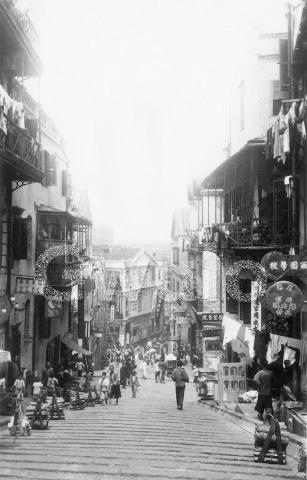
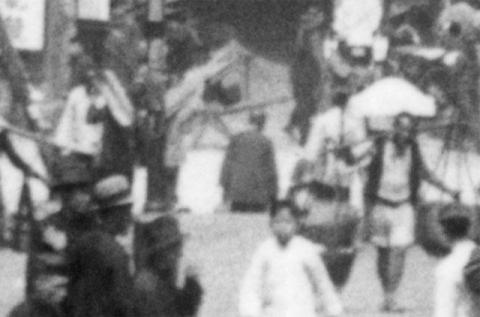
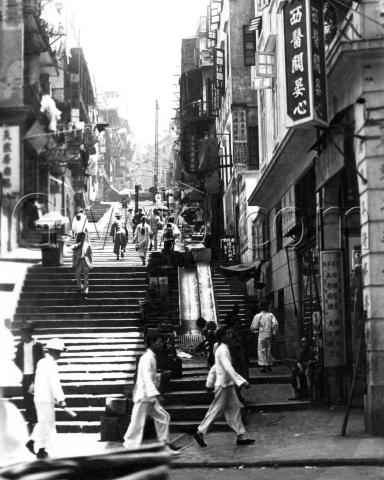
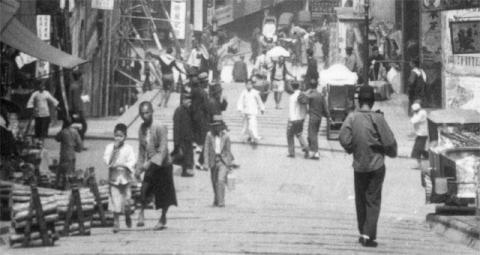
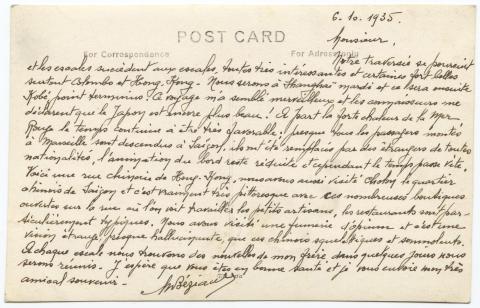
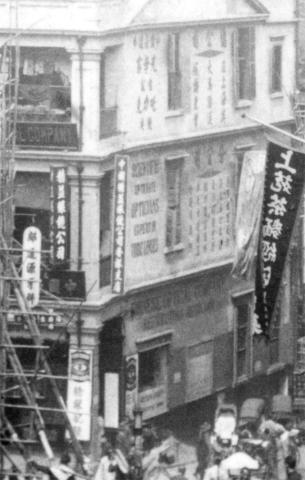
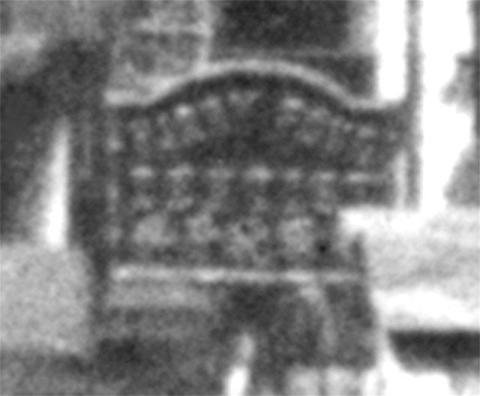
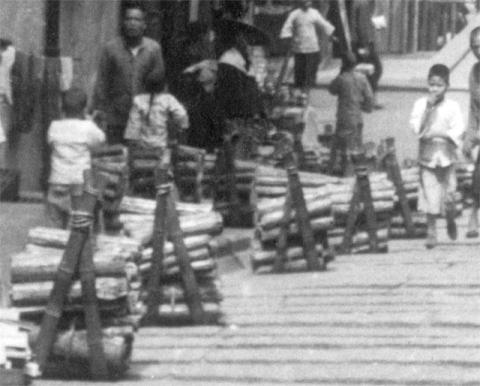
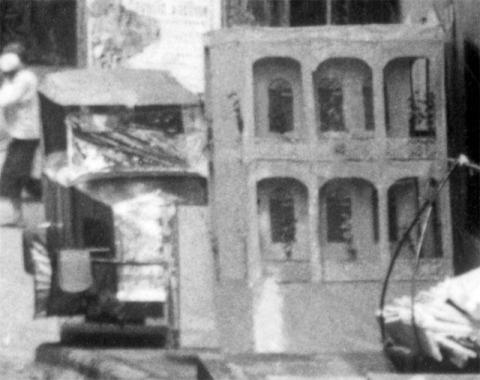

Comments
Curious Advertisement
The "curious advertisement" is for a famous make of talcum powder for babies.
curious advertisement
The brand is called "Two Girls" (the three characters from right to left) which still exists in Hong Kong today.
Postcard translation
The postcard is rather formal and addressed to someone referred to as "Sir". It gives an update of a journey from an unknown starting harbour to Japan. Given the stopovers mentioned it could possibly have been a ship from one of the main French merchant marine, the Messageries Maritimes or the Transat companies, which at the time had regular lines assuring mail, cargo and passenger transport between North America, Europe (France) and Asia. It was apparently the traveller's first journey to Asia.
"Our journey continues and stopovers follow each other, all very interesting and some beautiful, like Colombo and Hong Kong. We will reach Shanghai on Tuesday and then it will be Kobe, our final destination. This trip seems wonderful to me and connoisseurs assure me that Japan is even more beautiful.
Other than the terrible heat in the Red Sea region the weather continues to be really pleasant. Nearly all passengers who boarded the ship in Marseille disembarked in Saigon and they have been replaced by foreigners of all nationalities. The bustle on board is now reduced, however time flies quickly. Here is a Chinese street of Hong Kong. We also visited Cholon, the Chinese district of Saigon, which was really picturesque, with its many shops open on the streets where we could see artisans at work. Restaurants are particularly characteristic. We visited an opium house and it is a strange, nearly hallucinating vision to see these skeletal groggy Chinese.
At each stopover we find news from my brother, and in a few days we will be reunited. I hope this finds you in good health, best regards."
Re: Two Girls website
Hi There,
The Official website of Two Girls is up and running for some time.
T
Curious advertisement - talcum powder
It is amazing that the talcum powder is still available for sale! https://www.twogirls.hk/en/product_detail-80
Re: Ports Mentioned
I think the vessel would have belonged to the Messageries Maritimes. The steamer, "Marechal Joffre" that arrived in port on Saturday, 5 October from Saigon would have visited the ports mentioned in the postcard. It was the luxurious liner's first voyage to Hong Kong. Mention is made of this in the HK Telegraph on 7 October.
The vessel left Hong Kong on the same day of its arrival for Shanghai and Kobe.
Re: Bituminous coal
Bituminous coal is a typical coal for the industry. It was used e.g. for power production (e.g. first North Point plant), cement production (e.g. Green Island Cement), and other industrial uses.
Bituminous coal will not start to burn quickly, in the beginning it emits black smoke and soot which smells pretty bad (and is not healthy at all). So it's private use was mainly for domestic heating where you have a continuous fire. As this is not necessary in Hong Kong, I think almost all coal was used for industrial purposes.
So wood and charcoal were the main fuels for household cooking. In Chinese Restaurants or kitchens, possibly coal was used as they were cooking almost the whole day. The photo below is from 1980 and was taken in Chengdu, but I think that is similar to what was in use in Hong Kong in the 1930s.